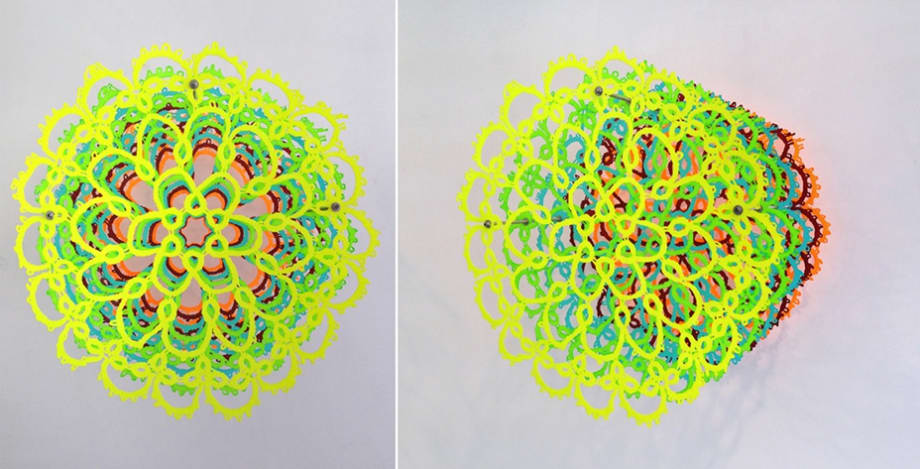ART REVIEW
“Susanna Starr: Hyperglo”
Bottom line: A compelling examination of form and color to alter perception.
Playing with perception, artist Susanna Starr makes sculptures that look like psychedelic snowflakes in a solo show at Midtown's Marcia Wood Gallery, appropriately titled "Hyperglo."
Starr’s method for creating her trippy, fluorescent, shape-shifting sculptures is unique.
The artist paints thin pieces of Mylar in neon shades of Shrek, safety cone orange and Tide blue roughly the size of a personal pizza, which she cuts into intricate patterns. Depending upon the particular elaborate shape Starr creates, the works can conjure up all sorts of associations: to Spirographs, kaleidoscopes, snowflakes, paper doilies (in fact, vintage lace doilies were the inspiration for these shapes), flowers, string art, op-art, organisms seen under a microscope, stained-glass windows and incandescent sea creatures. Starr then layers those variously colored ethereal shapes about 4 inches apart using hardware store nuts and bolts and projects them from the gallery wall.
From the side, the snowflakelike pieces jutting out from the wall in a soldierly row read one way. It’s like peeking behind the magician’s curtain to see the wizard at work.
But looking at Starr’s artworks head on, or moving side to side, the magic happens and the sculptures become a different animal entirely. Enlivened by their bright neon colors, the sculptures seem to glow with some internal light, a trick of the eye created by their intense hues. Stare at them long enough and you seem to be falling into their depths. The layers of intricate pattern create an incredible, disorienting sensation of something solid and whole, unlike the delicate layers when seen from the side.
A bit of a magician herself, Starr conveys an impressive sense of pulsating movement and suggestive energy out of these utterly static objects by playing with color, pattern and light in imaginative ways. In a secondary special effect, depending upon ambient light, the lacelike shapes create beautiful shadowed patterns on the walls.
Starr’s punchy titles play with suggestive associations, too. In “Yelo,” the predominant color is a shrieking, unnatural shade of Day Glo yellow that indeed recalls the assaultive neon hue of Mello Yello. “Groovy Kind of Love” suggests ’60s black light posters with its black vortexlike cutout backed by shades of green, blue and orange that give it a trippy glow. In “Hot House Flower,” the acid shades of Starr’s neon colors are intensified by the eyeball-gouging hot pink wall behind it. But Starr’s work hardly needs that sort of visual helping hand.
Starr seems after something transportive, mystical, even transcendental in her work that speaks to the human desire for altered states of consciousness and enlightenment and the power of art to take us there.

